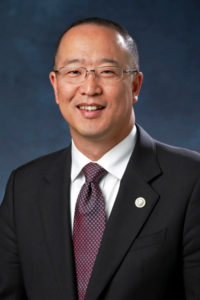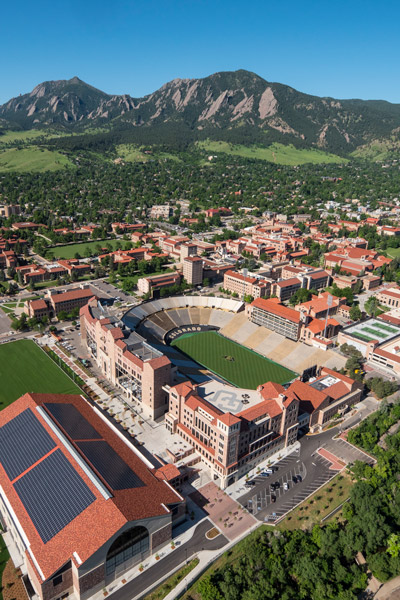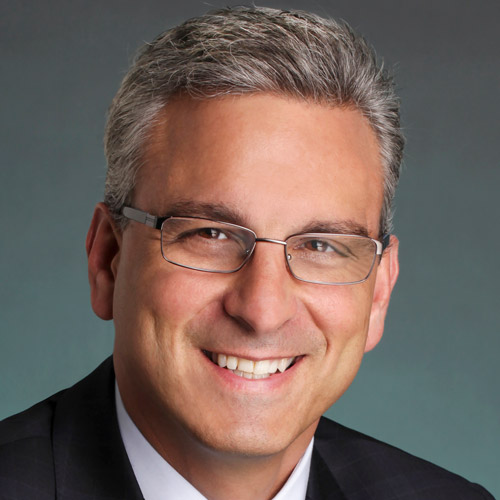
David Kang’s past career as a Navy Civil Engineer Corps officer is never more evident than when he talks about how he approaches facilities projects at the University of Colorado Boulder (CU Boulder). “Focus on the mission. Really understand why you’re there and what your role is,” he says.
The vice chancellor for infrastructure and safety at CU Boulder, Kang had already forged a storied career when he made the switch to higher education. He’d been a public works officer in charge of the Naval base in
Sasebo, Japan; helped the Department of the Navy surpass its 1 gigawatt renewable energy goal; and worked at the White House Military Office as a director for project management.
But when Kang got an offer to work for CU Boulder, he was overjoyed. “What a great opportunity to take what I’d learned in the Navy and bring it to higher education,” he says. “I thought it was a once-in-a-lifetime opportunity.”
Excellence in Sustainability
 Kang views Boulder as the perfect place to apply sustainability to higher education. “Being in Boulder, there are these phenomenal opportunities that are perhaps not as present in other locations,” he says. “Twenty miles down the road in Golden, Colorado, we have the National Renewable Energy Lab. Next door to us we have the National Oceanic and Atmospheric Administration. We also have the National Center for Atmospheric Research—all within a stone’s throw of campus.”
Kang views Boulder as the perfect place to apply sustainability to higher education. “Being in Boulder, there are these phenomenal opportunities that are perhaps not as present in other locations,” he says. “Twenty miles down the road in Golden, Colorado, we have the National Renewable Energy Lab. Next door to us we have the National Oceanic and Atmospheric Administration. We also have the National Center for Atmospheric Research—all within a stone’s throw of campus.”
Additionally, Kang believes that the esprit de corps at CU Boulder helps to facilitate economic and sustainable changes on the campus. “CU Boulder has been on the forefront of sustainability for many years,” he explains. “I think the desire to be excellent in sustainability has been here, and it’s been here for a long time.”
Kang also praises CU Boulder’s student body for its willingness to think globally. “We have a very active student body here,” he says. “Our Environmental Center was actually created by students. They created the first recycling program here on campus about 40 years ago. We have very active students who are interested in what’s happening around the world. The students are a strong force and ally in all of these initiatives.”
With all of these pieces in one place, Kang sees his position as a means of getting them working together to be more than the sum of their parts, and working within the campus to increase its resiliency.
“I really believe that my job at CU Boulder is to make the campus more resilient,” he says. “Despite what happens around us—whether it’s a flood, or a fire, or snow—my job is to keep the lights on and make sure that the students can learn and the faculty can do their research.”
Asking the Right Questions
As part of these resiliency initiatives, Kang and CU Boulder are embarking on a campus visioning effort to see what the campus’s needs are moving forward. “Effective campus planning is critical,” he says. “It’s always easy to do what the customer asks for.” In this case, Kang is referring to a campus program that might need a new building for specific research. But simply fulfilling the customer’s requests is not enough for Kang.
“Changing our mind-set from doing what we’re asked to actually asking the right questions so you can get the requirements is part of the visioning effort,” he explains. “Why are you asking for a new building? Is it because your labs are inadequate? Is it because you don’t have enough space for all of your faculty and students? Is it because your program is growing?”
These questions are integral to effective and sustainable planning and to help avoid unnecessary construction. “I have a saying that the most efficient building is the one that we don’t build,” he says with a laugh. “So any time a proposal for a new building arises, my preference would be to first figure out how we optimize the spaces that we have to meet those emerging requirements.”
Kang also encourages renovations that focus on shared spaces, not offices, a testament to his commitment to collaboration. “I love being part of the university atmosphere,” he says. “The folks that are here, especially the faculty, really want to make a difference in the world, and that’s one of the things that attracted me to higher education: having the opportunity to collaborate with faculty and students. I really care about the world we live in. I just happened to be in the perfect place at the perfect time where I can be part of the university fabric that is making a difference every day.”
Impact Beyond the Campus
CU Boulder’s David Kang has also found a great deal of success leveraging connections with some of the city’s largest industrial players. Kang has worked with faculty, students, and leaders in the tech industry to explore how new technologies can be integrated to create a more
resilient and sustainable campus. His focus is not only on the campus, but also on how CU Boulder impacts the
larger community in terms of energy use, integration of smart technologies and artificial intelligence, emissions reduction, and sustainable multimodal transportation options, among other things.
“One example of this is the multiple discussions we’ve had with the city of Boulder and others about how we can provide mobility options beyond personal vehicles so that we can enhance the experience here on campus and in the city,” Kang says. “Transportation will be key to how we navigate on campus, especially across the different areas we have here. Transportation’s critical to that, and we want to do it sustainably and responsibly.”
Photos: Glenn J. Asakawa/University of Colorado Boulder


